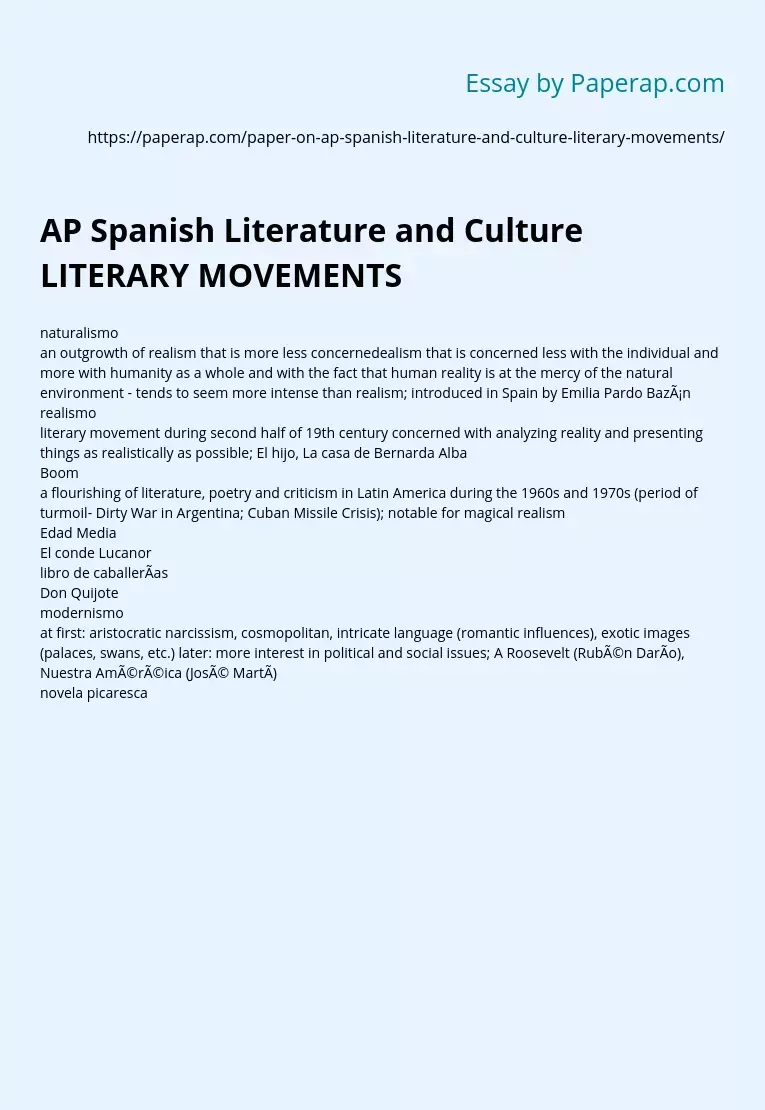AP Spanish Literature and Culture LITERARY MOVEMENTS
Essay,
Pages 3 (572 words)
Views
69
naturalismo
an outgrowth of realism that is more less concernedealism that is concerned less with the individual and more with humanity as a whole and with the fact that human reality is at the mercy of the natural environment – tends to seem more intense than realism; introduced in Spain by Emilia Pardo Bazán
realismo
literary movement during second half of 19th century concerned with analyzing reality and presenting things as realistically as possible; El hijo, La casa de Bernarda Alba
Boom
a flourishing of literature, poetry and criticism in Latin America during the 1960s and 1970s (period of turmoil- Dirty War in Argentina; Cuban Missile Crisis); notable for magical realism
Edad Media
El conde Lucanor
libro de caballerías
Don Quijote
modernismo
at first: aristocratic narcissism, cosmopolitan, intricate language (romantic influences), exotic images (palaces, swans, etc.)
later: more interest in political and social issues; A Roosevelt (Rubén Darío), Nuestra Améréica (José Martí)
later: more interest in political and social issues; A Roosevelt (Rubén Darío), Nuestra Améréica (José Martí)
novela picaresca
Lazarillo de Tormes
realismo mágico
used magical elements and events in otherwise ordinary and realistic situations; El ahogado más hermoso del mundo
Renacimiento
Spanish cultural movement strongly influenced by Italian humanism; Garcilaso de la Vega
conceptismo
a Baroque literary movement characterized by a rapid rhythm, directness, simple vocabulary, witty metaphors, and wordplay; multiple meanings are conveyed in a very concise manner, and conceptual intricacies are emphasized over elaborate vocabulary; Quevedo
culteranismo
a Baroque period literary movement characterized by ostentatious vocabulary, complex syntactical order, multiple, complicated metaphors, but highly conventional content; Góngora
existencialismo
philosophy/literature focused on the belief that humans are powerful and are therefore responsible for what happens to them and have the ability to create individual meaning for themselves; Unamuno
postmodernismo
literature that aimed to surpass modernism using paradox, questionable narrators, fantasy, etc.; mostly after WWII; includes magic realism, theater of the absurd , and feminist literature
vanguardismo
avant-garde movements of literary experimentation; includes the surrealist movement (concerned with dreams and hallucinations); Pablo Neruda, Dragún, Lorca
teatro del absurdo
with the belief that human existence has no meaning or purpose, these works are intentionally ridiculous, showing man in an illogical, incomprehensible world – yet still carrying a meaningfull message; dialogue includes clichés and word games; Dragún
Generación del 98
a group of novelists, poets, essayists, and philosophers active in Spain at the time of the Spanish-American War; criticism, ideals, creativity; included Miguel de Unamuno (religious themes), Antonio Machado (personal and universal themes)
costumbrismo
a literary interpretation of local everyday life and customs (19th century); romantic interest in extravagant expression + realistic, precise focus on a particular time and place; preceded (and led to) both Romanticism and Realism
barroco
a 17th-century cultural and artistic movement that was the evolution of ideas and themes formulated during the Spanish Renaissance; included culteranismo and conceptismo; Góngora and Quevedo in Spain + Sor Juana in Mexico
romanticismo
in response to neoclassicism, this movement focused on the beauty of imagination, the irregular nature of human spirit, and the natural world; Rima LIII (Bécquer), En una tempestad (Heredia)
Siglo de Oro
period from 1942 (Christopher Columbus, end of Reconquista) to 1659 characterized by a flourishing in Spanish arts and literature that included romantecismo and barroco; Don Quijote, Garcilaso, Góngora, Quevedo
neoclasicismo
movement in which writers looked back to figures such as Garcilaso and Quevedo and were inspired by classical ideals; later prompted a negative reaction from romanticists, who were themselves criticized by realists
AP Spanish Literature and Culture LITERARY MOVEMENTS. (2018, Feb 14). Retrieved from https://paperap.com/paper-on-ap-spanish-literature-and-culture-literary-movements/
